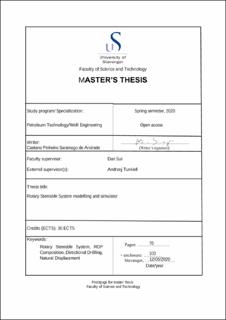| dc.contributor.advisor | Sui, Dan | |
| dc.contributor.advisor | Tunkiel, Andrzej | |
| dc.contributor.author | Pinheiro Saramago de Andrade, Caetano | |
| dc.coverage.spatial | North Sea, US and Latino America | en_US |
| dc.date.accessioned | 2020-10-28T09:18:56Z | |
| dc.date.available | 2020-10-28T09:18:56Z | |
| dc.date.issued | 2020-06-12 | |
| dc.identifier.uri | https://hdl.handle.net/11250/2685429 | |
| dc.description | Master's thesis in Petroleum engineering | en_US |
| dc.description.abstract | Nowadays, there is a fact in the oil industry: directional drilling is a common and essential procedure in major drilling operations. With the development of technologies that allows horizontal and multilateral wells, the percentage of recoverable oil has increased. This fact represents the main motivation of this master thesis. In other words, this master thesis aims to contribute to the development and further understanding of directional drilling, more specifically on the Rotary Steerable System (RSS) technology. Working in partnership with the industry, this thesis aims to model a Rotary Steerable System.
Whenever a directional drilling process has started, there is a point called the kickoff point, where a vertical well intentionally deviates from the vertical direction. The RSS is a method, among several, that can be used to give an angle to the drilling path. Classical definitions from fundamental physics, as Newton’s third law and beam-bending analysis, and original definitions developed by this thesis, as the ROP composition and force on the bit analysis, will be used to model and foresee the behavior of the RSS system. Every step of modelling will be described starting from the first simple idea until the most sophisticated model simulator.
The RSS system, used as a foundation of the mathematical model, is a commercial system from Canrig Drilling Technology Norway. Costs and specific characteristics of the system will not be exposed. The main physical concepts and behavior will be studied and modelled in this thesis. | en_US |
| dc.language.iso | eng | en_US |
| dc.publisher | University of Stavanger, Norway | en_US |
| dc.relation.ispartofseries | Masteroppgave/UIS-TN-IEP/2020; | |
| dc.rights | Navngivelse-Ikkekommersiell-DelPåSammeVilkår 4.0 Internasjonal | * |
| dc.rights.uri | http://creativecommons.org/licenses/by-nc-sa/4.0/deed.no | * |
| dc.subject | petroleumsteknologi | en_US |
| dc.subject | boreteknologi | en_US |
| dc.subject | ROP Composition | en_US |
| dc.subject | rotary steerable system | en_US |
| dc.subject | directional drilling | en_US |
| dc.subject | natural displacement | en_US |
| dc.title | Rotary Steerable System modelling and simulator | en_US |
| dc.type | Master thesis | en_US |
| dc.subject.nsi | VDP::Teknologi: 500::Berg‑ og petroleumsfag: 510::Petroleumsteknologi: 512 | en_US |

